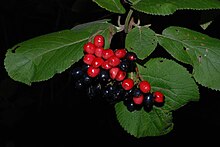Musk plants
| Musk plants | ||||||||||||
|---|---|---|---|---|---|---|---|---|---|---|---|---|

Japanese elderberry ( Sambucus racemosa subsp. Sieboldiana ) |
||||||||||||
| Systematics | ||||||||||||
|
||||||||||||
| Scientific name | ||||||||||||
| Adoxaceae | ||||||||||||
| E. Mey. |
The musk herbs (Adoxaceae) are a family of plants from the order of the cardiac plants (Dipsacales). Since 2011 it contains four genera with around 220 plant species mainly in the northern hemisphere .
description


Since this family was grouped according to molecular genetic knowledge, only a few characteristics are common to all genera.
Vegetative characteristics
With the exception of the few genera Adoxa and Sinadoxa , which grow as small perennial herbaceous plants , most of the species are woody plants that usually grow as shrubs , more rarely as small trees .
All kinds of Adoxaceae have opposite leaves . The leaf blades are simple ( Viburnum ) or compound ( Sambucus , Adoxa and Sinadoxa ).
Generative characteristics
The terminal, ährigen , rispigen , doldigen or capitate , usually zymösen inflorescences contain few to many flowers.
The often relatively small flowers are hermaphroditic, radial symmetry and usually five-fold, more rarely three to four-fold. Most of the five sepals are fused and the calyx is open during development. The mostly five petals are fused and the corolla lobes are often arranged flat in the shape of a wheel. With the outer one, there is only a circle with free, fertile stamens inserted into the corolla tube. The number of stamens varies from five in Sambucus and Viburnum to five, four or three stamens in Adoxa and Sinadoxa. In Adoxa and Sinadoxa , the stamens are split almost to the bottom, giving the impression that there are twice as many stamens. The dust bags open with a longitudinal slit. With the inner stamen circle there is a circle with five, four or three staminodes . Three, four or five carpels are fused into a semi-subordinate to subordinate, one- or three- to five- chamber ovary. There are one, three, four or five mostly short styluses or it is missing. The scars are heady or two to three parts.
The stone fruit contains one or three to five seeds.
Systematics



The Adoxaceae family was established in 1839 by Ernst Heinrich Friedrich Meyer in Prussia's plant genera , page 198. Type genus is Adoxa L. Synonyms for Adoxaceae E. Mey. nom. cons. are Sambucaceae Batsch ex Borkh. and Viburnaceae Raf.
Gene sequence analyzes show that the genera Adoxa and Sinadoxa, together with the genera Sambucus and Viburnum, which were formerly part of the family Caprifoliaceae , have a common ancestry and should therefore be placed in one family. They form a monophyletic family in the order Dipsacales according to the systematics of the bedecktsamer according to APG IV (2016) .
The family Adoxaceae contains four genera with about 220 species since 2011:
- Adoxa L. (Syn .: Moscatella Adans. , Moschatellina Mill. , Tetradoxa C.Y.Wu ): The three or four species are distributed in the temperate areas of the northern hemisphere:
-
Sinadoxa C.Y.Wu, ZLWu & RFHuang : It contains only one species:
- Sinadoxa corydalifolia C.Y.Wu, ZLWu & RFHuang : This endemic thrives on rocky overhangs, in wet gorges and alpine rock debris at altitudes of 3900 to 4800 meters in China only in Nangqên and Yushu in southern Qinghai .
- Elderberry ( Sambucus L. ): It contains only about ten (previously up to 40) species in temperate to subtropical areas and tropical mountains.
- Snowball ( Viburnum L. , Syn .: Actinotinus Oliv. ): The approximately 200 species are mainly found in temperate to subtropical areas of Asia and South America ; 73 of them occur in China.
swell
- Adoxaceae E. Meyen, nom. cons. In: Angiosperm Phylogeny Website - Online . Retrieved January 28, 2012 . (Sections systematics and description)
- Deyuan Hong, Qiner Yang, Valéry Malécot & David E. Boufford: Adoxaceae . In: Flora of China Editorial Committee: Wu Zheng-yi, Peter H. Raven & Deyuan Hong (Eds.): Flora of China . Cucurbitaceae through Valerianaceae, with Annonaceae and Berberidaceae. tape 19 . Science Press and Missouri Botanical Garden Press, Beijing and St. Louis 2011, ISBN 978-1-935641-04-9 , pp. 570–616 (English, - same text online as the printed work. ). (Sections Description, Distribution and Systematics)
Individual evidence
- ^ Adoxaceae at Tropicos.org. Missouri Botanical Garden, St. Louis, accessed January 28, 2012.
- ^ Adoxaceae in the Germplasm Resources Information Network (GRIN), USDA , ARS , National Genetic Resources Program. National Germplasm Resources Laboratory, Beltsville, Maryland. Retrieved January 28, 2012.
- ↑ J. Reveal: Proposals to conserve the name Viburnaceae (Magnoliophyta), the name Adoxaceae against Viburnaceae, a “superconservation” proposal, and as an alternative, the name Sambucaceae. In: Taxon , Volume 57, 2008, p. 303.
- ↑ The Angiosperm Phylogeny Group: An update of the Angiosperm Phylogeny Group classification for the orders and families of flowering plants: APG IV . Botanical Journal of the Linnean Society, 2016, Volume 181, pp. 1-20. doi : 10.1111 / boj.12385
- ↑ ADOXACEAE E. Meyen, nom. cons. In: Angiosperm Phylogeny Website - Online . Retrieved May 10, 2014 .
- ↑ a b c d e Deyuan Hong, Qiner Yang, Valéry Malécot & David E. Boufford: Adoxaceae . In: Flora of China Editorial Committee: Wu Zheng-yi, Peter H. Raven & Deyuan Hong (Eds.): Flora of China . Cucurbitaceae through Valerianaceae, with Annonaceae and Berberidaceae. tape 19 . Science Press and Missouri Botanical Garden Press, Beijing and St. Louis 2011, ISBN 978-1-935641-04-9 , pp. 570–616 (English, - same text online as the printed work. ).